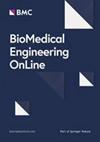Voxel-wise body composition analysis using image registration of a three-slice CT imaging protocol: methodology and proof-of-concept studies
IF 2.9
4区 医学
Q3 ENGINEERING, BIOMEDICAL
引用次数: 0
Abstract
Computed tomography (CT) is an imaging modality commonly used for studies of internal body structures and very useful for detailed studies of body composition. The aim of this study was to develop and evaluate a fully automatic image registration framework for inter-subject CT slice registration. The aim was also to use the results, in a set of proof-of-concept studies, for voxel-wise statistical body composition analysis (Imiomics) of correlations between imaging and non-imaging data. The current study utilized three single-slice CT images of the liver, abdomen, and thigh from two large cohort studies, SCAPIS and IGT. The image registration method developed and evaluated used both CT images together with image-derived tissue and organ segmentation masks. To evaluate the performance of the registration method, a set of baseline 3-single-slice CT images (from 2780 subjects including 8285 slices) from the SCAPIS and IGT cohorts were registered. Vector magnitude and intensity magnitude error indicating inverse consistency were used for evaluation. Image registration results were further used for voxel-wise analysis of associations between the CT images (as represented by tissue volume from Hounsfield unit and Jacobian determinant) and various explicit measurements of various tissues, fat depots, and organs collected in both cohort studies. Our findings demonstrated that the key organs and anatomical structures were registered appropriately. The evaluation parameters of inverse consistency, such as vector magnitude and intensity magnitude error, were on average less than 3 mm and 50 Hounsfield units. The registration followed by Imiomics analysis enabled the examination of associations between various explicit measurements (liver, spleen, abdominal muscle, visceral adipose tissue (VAT), subcutaneous adipose tissue (SAT), thigh SAT, intermuscular adipose tissue (IMAT), and thigh muscle) and the voxel-wise image information. The developed and evaluated framework allows accurate image registrations of the collected three single-slice CT images and enables detailed voxel-wise studies of associations between body composition and associated diseases and risk factors.利用三片 CT 成像方案的图像配准进行体素体成分分析:方法和概念验证研究
计算机断层扫描(CT)是一种常用于人体内部结构研究的成像模式,对于人体成分的详细研究非常有用。这项研究的目的是开发和评估一个用于主体间 CT 切片配准的全自动图像配准框架。目的还在于在一组概念验证研究中将结果用于对成像数据和非成像数据之间的相关性进行体素统计身体成分分析(Imiomics)。目前的研究利用了 SCAPIS 和 IGT 两项大型队列研究中的肝脏、腹部和大腿的三张单片 CT 图像。开发和评估的图像配准方法使用了两张 CT 图像以及图像衍生的组织和器官分割掩膜。为了评估配准方法的性能,对 SCAPIS 和 IGT 队列中的一组基线 3 片 CT 图像(来自 2780 名受试者,包括 8285 个切片)进行了配准。矢量幅度和强度幅度误差表示反向一致性,用于评估。图像配准结果被进一步用于对 CT 图像(由 Hounsfield 单位和 Jacobian 行列式表示的组织体积)与这两项队列研究中收集的各种组织、脂肪层和器官的各种明确测量值之间的关联进行体素分析。我们的研究结果表明,关键器官和解剖结构都得到了适当的登记。反向一致性的评估参数,如矢量幅度和强度幅度误差,平均小于 3 毫米和 50 Hounsfield 单位。配准后进行 Imiomics 分析,可检查各种明确测量值(肝脏、脾脏、腹肌、内脏脂肪组织 (VAT)、皮下脂肪组织 (SAT)、大腿脂肪组织 (SAT)、肌间脂肪组织 (IMAT) 和大腿肌肉)与体素图像信息之间的关联。所开发和评估的框架可对所收集的三张单片 CT 图像进行精确的图像注册,并可对身体成分与相关疾病和风险因素之间的关联进行详细的体素研究。
本文章由计算机程序翻译,如有差异,请以英文原文为准。
求助全文
约1分钟内获得全文
求助全文
来源期刊

BioMedical Engineering OnLine
工程技术-工程:生物医学
CiteScore
6.70
自引率
2.60%
发文量
79
审稿时长
1 months
期刊介绍:
BioMedical Engineering OnLine is an open access, peer-reviewed journal that is dedicated to publishing research in all areas of biomedical engineering.
BioMedical Engineering OnLine is aimed at readers and authors throughout the world, with an interest in using tools of the physical and data sciences and techniques in engineering to understand and solve problems in the biological and medical sciences. Topical areas include, but are not limited to:
Bioinformatics-
Bioinstrumentation-
Biomechanics-
Biomedical Devices & Instrumentation-
Biomedical Signal Processing-
Healthcare Information Systems-
Human Dynamics-
Neural Engineering-
Rehabilitation Engineering-
Biomaterials-
Biomedical Imaging & Image Processing-
BioMEMS and On-Chip Devices-
Bio-Micro/Nano Technologies-
Biomolecular Engineering-
Biosensors-
Cardiovascular Systems Engineering-
Cellular Engineering-
Clinical Engineering-
Computational Biology-
Drug Delivery Technologies-
Modeling Methodologies-
Nanomaterials and Nanotechnology in Biomedicine-
Respiratory Systems Engineering-
Robotics in Medicine-
Systems and Synthetic Biology-
Systems Biology-
Telemedicine/Smartphone Applications in Medicine-
Therapeutic Systems, Devices and Technologies-
Tissue Engineering
 求助内容:
求助内容: 应助结果提醒方式:
应助结果提醒方式:


